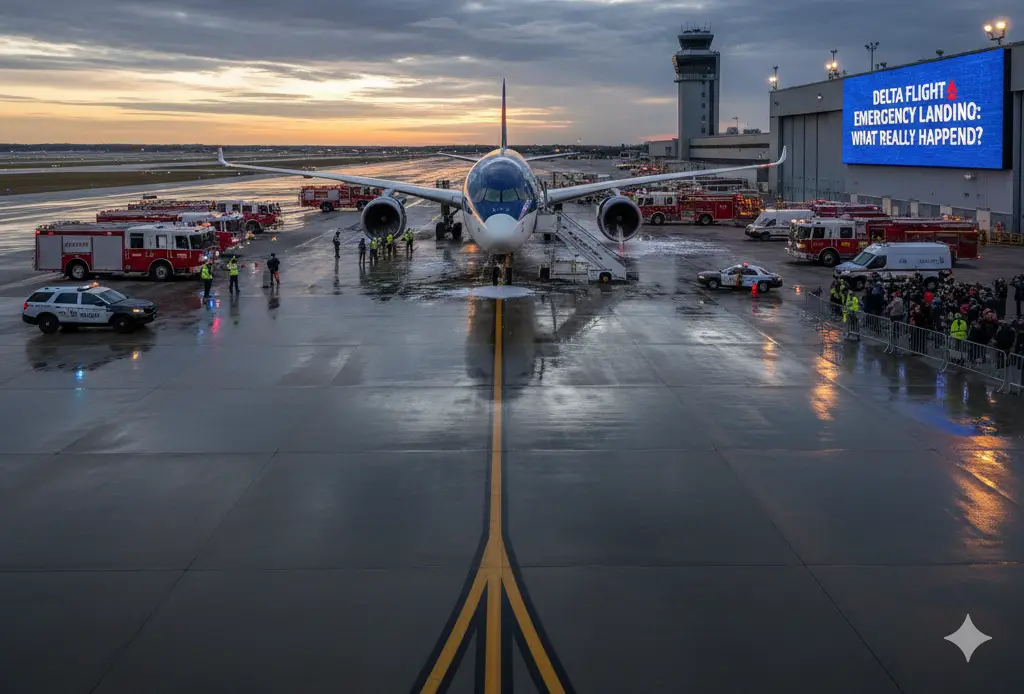The phrase “emergency landing” triggers immediate concern among air travelers, conjuring images of potential disaster and chaos in the skies. When such incidents involve major carriers like Delta Air Lines, one of the world’s largest and most respected airlines, public attention intensifies dramatically. Recent months have seen multiple Delta flights making unexpected landings under emergency circumstances across various routes. What truly transpires when a pilot declares an emergency? How do these professionals manage critical situations thousands of feet in the air? This article investigates the reality behind these alarming headlines, separating sensationalism from standard safety protocols. By examining specific incidents, understanding aviation procedures, and hearing directly from passengers, we reveal the comprehensive safety framework that guides every decision during airborne emergencies. The reality of these situations often contrasts sharply with passenger perceptions, highlighting the extensive training and redundant safety systems that operate behind the scenes to ensure safety remains the unwavering priority throughout any aviation emergency.
The Flight DL137 Emergency: A Case Study
Timeline of Events
On November 14, 2025, Delta Air Lines Flight DL137 became another addition to aviation incident databases. The Airbus A330-300, approximately 19 years old, had departed from Amsterdam Schiphol Airport (AMS) bound for Detroit Metropolitan Wayne County Airport (DTW). The flight took off at 15:55 CET, already operating with an hour-long delay before its emergency began .
Approximately 90 minutes into the transatlantic journey, while cruising at 35,000 feet over the Atlantic, the flight crew made the critical decision to declare an emergency. The pilots squawked the universal emergency code 7700 on the aircraft’s transponder, alerting air traffic control to their situation. Rather than continuing across the ocean, the aircraft executed a sharp turnaround and diverted toward Dublin, Ireland . The plane landed safely at Dublin Airport (DUB) at 18:20 GMT, approximately two hours and twenty-five minutes after its initial departure from Amsterdam .
The Mystery and the Response
As of November 15, 2025, Delta Air Lines had not officially confirmed the specific cause behind the emergency declaration . Aviation experts note that such diversions can result from various issues, including medical emergencies, technical malfunctions, or adverse weather conditions . The decision to divert to Dublin rather than continue to Detroit exemplifies standard aviation safety protocols, prioritizing the nearest suitable airport when any question of safety emerges .
Following the safe landing, Dublin Airport’s emergency response teams, including fire services, were on standby as a precautionary measure, largely due to the significant fuel load still aboard the aircraft designed for a long-haul transatlantic crossing . The landing was reportedly “heavy” due to this excess weight but concluded without incident . Delta’s ground crew and Dublin Airport staff coordinated to ensure all passengers were safely evacuated and their immediate needs addressed. The airline provided on-site support including medical checks and refreshments, and thankfully, no injuries were reported . Affected passengers were rebooked on alternative flights to reach their original destination, though some delays were inevitable .
Other Recent Delta Emergency Landings: A Pattern of Incidents
Flight DL137 is not an isolated case in recent months. Delta Air Lines has experienced several emergency situations requiring diversions or unexpected landings, each with unique circumstances but all demonstrating the airline’s operational response protocols.
*Table: Recent Delta Air Lines Emergency Landings (July – November 2025)*
| Flight Route | Date | Aircraft | Cause of Diversion | Diversion Airport | Passenger Impact |
| DL137 | AMS → DTWNov 14, 2025 | Airbus A330-300 | Unconfirmed Emergency | Dublin (DUB) | Rebooked on alternative flights |
| DL45 | Dublin → JFKNov 2025 | – | Engine Failure | Keflavík, Iceland (KEF) | Overnight in Iceland |
| DL389 | DTW → ShanghaiNov 2025 | Airbus A350-900 | Pilot Illness | Los Angeles (LAX) | 24-hour journey delay |
| DL56 | SLC → AmsterdamJul 31, 2025 | – | Severe Turbulence | Minneapolis-St. Paul (MSP) | 25 hospitalized |
| Flight from Madrid | MAD → NYCJul 6, 2025 | – | Engine Trouble | Azores, Portugal | Accommodation challenges |
Engine and Mechanical Issues: In September 2025, a Delta flight from Atlanta to Sacramento returned to Atlanta shortly after takeoff when passengers captured video showing sparks flying from one of the aircraft’s engines. The Boeing aircraft landed safely and taxied to the gate under its own power . Similarly, in a separate incident, Delta Flight DL45 from Dublin to New York JFK was forced to make an emergency landing in Iceland after reportedly experiencing engine failure midair over the Atlantic. Passengers described moments of panic as the cabin allegedly plunged into darkness and flight attendants instructed passengers to grab life vests .- Medical Emergencies: Operational diversions aren’t always due to mechanical problems. In November 2025, Delta Flight DL389 from Detroit to Shanghai diverted approximately 4,000 kilometers off course to Los Angeles after the operating captain fell ill and reported being unfit to continue. Passengers remained onboard during a three-hour wait while Delta located a replacement pilot, extending the total journey time to approximately 24 hours .
- Severe Weather and Turbulence: On July 31, 2025, Delta Flight DL56 from Salt Lake City to Amsterdam encountered severe turbulence over southwestern Wyoming, forcing an emergency landing at Minneapolis-Saint Paul International Airport. The turbulence sent service carts and unbelted passengers into the air, resulting in 25 people being transported to hospitals for evaluation and care . One passenger described experiencing three waves of turbulence progressing from “bad, to worse and way worse,” while another called it “the craziest turbulence I’ve ever seen in my life” .
Aviation Safety Protocols: The Unseen Framework
The Decision to Divert
The consistent thread running through all these incidents is the crew’s decision to divert rather than continue to the planned destination. This critical choice follows established safety protocols that prioritize the immediate safety of passengers and crew over operational convenience or schedule adherence. Pilots undergo extensive training to evaluate potential emergencies against a set of standardized criteria, often summarized by the “five hazardous attitudes” that crews are trained to recognize and avoid: anti-authority, impulsivity, invulnerability, machoism, and resignation.
When an emergency occurs, pilots follow specific checklists designed to address the issue while continuously assessing whether continuing the flight represents the safest option. The declaration of an emergency via squawk code 7700, as seen in Flight DL137, immediately alerts air traffic control to prioritize the aircraft, clearing airspace and preparing emergency services . This declaration also triggers a coordinated response from the airline’s operations center, which begins planning for the diversion, including arranging ground support, maintenance, and passenger care at the diversion airport.
Passenger Management and Care
Once the immediate air emergency concludes with a safe landing, the focus shifts to passenger welfare and logistics. Delta’s official policy includes providing accommodations, transportation, and meals during extended delays, though execution has varied significantly in practice . In the Azores diversion, for instance, the airline secured 160 hotel rooms on the remote island, but communication breakdowns left many passengers scrambling to make their own arrangements before learning about the offered accommodations .
The difference between a well-managed diversion and a frustrating passenger experience often comes down to communication effectiveness and ground support availability. At airports where Delta maintains regular operations, such as Dublin or Minneapolis, response typically runs more smoothly thanks to existing ground staff and established procedures . At more remote diversion points like the Azores or Iceland, the airline must rely on contracted airport personnel, which can sometimes lead to delays in assistance .
Passenger Experiences: From Gratitude to Frustration
The human element of emergency landings reveals a spectrum of responses, from terror to gratitude, and often frustration during the aftermath. Passengers aboard the turbulence-plagued Flight DL56 described a genuinely terrifying experience. “I truly thought the plane was going to go down,” said passenger Joseph Carbone, who watched as a “flight attendant just about crashed into the ceiling” . Another passenger, William Webster, who takes approximately 80 flights annually, described it as “the craziest turbulence I’ve ever seen in my life” .
Following the engine failure incident on Flight DL45 over the Atlantic, passenger Lohanny Santos shared her terror on TikTok, stating, “I kid you not, I thought we were going to die” . She noted that Irish TV host Martin King comforted her throughout the incident, highlighting how passengers often support one another during frightening situations .
Perhaps the most consistent frustration emerges during the aftermath of diversions, particularly at remote airports. Marc, a passenger on the Madrid to New York flight that diverted to the Azores, reported being “deeply unsettled by Delta’s total communication breakdown in the aftermath.” He described having no live updates, no ground support or personnel, and no personal acknowledgment of the situation until already en route back to New York . Despite Delta’s media statements claiming accommodations, transportation, and meals were provided, Marc and other passengers contradicted this, saying they scrambled to make their own arrangements .
These accounts highlight a significant gap between corporate communications and on-the-ground reality in some diversion scenarios. While Delta spokesman Morgan Durrant confirmed the company did secure 160 hotel rooms on the Azores island, the communication failure meant many passengers like Marc had already booked their own accommodations before learning of the available rooms .
Conclusion
Emergency landings, while dramatic and concerning, represent the aviation system’s built-in safety mechanisms operating precisely as designed. The recent series of Delta Air Lines incidents reveals not a pattern of declining safety standards, but rather the rigorous application of precautionary principles when any anomaly occurs during flight. From squawking 7700 over the Atlantic to diverting for ill pilots or returning for sparking engines, each decision follows the fundamental aviation mantra: safety above all else.
For passengers, these incidents understandably generate anxiety and frustration, particularly when communication falters during the aftermath. Yet the consistent outcome across all these emergencies has been the safe landing of all aircraft and passengers. As aviation continues to be statistically one of the safest modes of transportation, these events serve as both reassurance and reminder. They demonstrate the extensive training of flight crews, the robustness of modern aircraft, and the comprehensive safety protocols that guide every decision when unexpected situations arise. While customer care following diversions shows room for improvement, the fundamental safety outcomes reaffirm public confidence in aviation’s unwavering commitment to protecting lives above all other considerations.
Frequently Asked Questions (FAQ)
Table: Common Questions About Delta Air Lines Emergency Landings
| Question | Answer |
| What does “squawk 7700” mean? | Squawk 7700 is the transponder code that pilots set to declare an emergency to air traffic control. It immediately alerts ground controllers that the aircraft requires priority handling and potential assistance . |
| Why do flights divert to different countries instead of returning? | Pileters follow strict protocols to land at the nearest suitable airport when facing emergencies. Over the Atlantic, this often means diverting to airports in Ireland, Iceland, or Canada rather than returning to the origin . |
| What compensation are passengers entitled to after a diversion? | Under European law, passengers may be entitled to 600 euros for significant delays on routes involving EU airports. Otherwise, Delta typically offers hotel accommodations, meals, and rebooking, though execution has varied . |
| How common are emergency diversions? | Statistically, emergencies requiring diversions are rare, occurring in approximately one in 10,000 flights. The vast majority of these incidents are resolved safely thanks to established protocols . |
| What should passengers do during an emergency landing? | Follow crew instructions immediately, secure your seatbelt tightly, stow loose items, and assume the brace position if instructed. Remain calm and avoid spreading panic among fellow passengers . |
| Are older aircraft less safe? | Not necessarily. All commercial aircraft regardless of age undergo rigorous maintenance checks and must meet identical safety standards. The 19-year-old A330 involved in the Dublin diversion received the same safety oversight as newer models . |
| How can passengers stay informed during a diversion? | Airlines recommend using their official website or mobile app for updates. For real-time flight tracking, services like FlightAware can provide detailed information on aircraft status and routing . |


